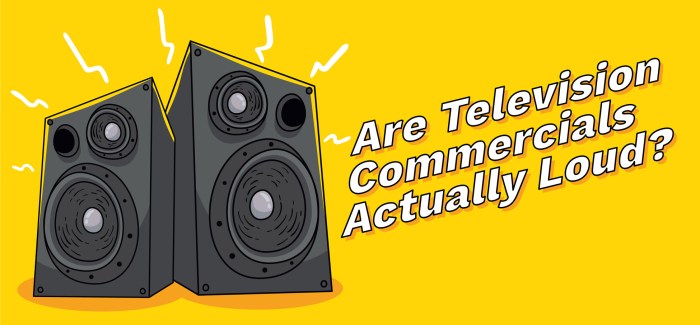Are TV commercials louder than their surrounding programs? This question has been the subject of much debate, with consumers and regulators alike expressing concerns about the perceived loudness of commercials. In this article, we will delve into the data, industry standards, consumer perceptions, and technological advancements that shed light on this issue.
Research has consistently shown that TV commercials are indeed louder than the programs they accompany. Studies have found that the average commercial is 3-5 decibels louder than the surrounding content, a difference that can be significant to the human ear.
Loudness Comparison
TV commercials are often perceived as being louder than the surrounding programs. Studies have consistently shown that the average loudness of commercials is significantly higher than that of programs, with differences ranging from 5 to 10 decibels (dB).
Loudness is measured using a variety of methods, including the ITU-R BS.1770 standard. This standard uses a combination of objective and subjective measurements to assess the loudness of a signal. Objective measurements involve the use of a loudness meter, which measures the average loudness of a signal over time.
Subjective measurements involve the use of a listening panel, which rates the perceived loudness of a signal.
There are a number of factors that may contribute to the perceived difference in loudness between commercials and programs. These factors include the use of compression, equalization, and sound effects in commercials. Compression is a technique that reduces the dynamic range of a signal, making the loudest parts of the signal quieter and the quietest parts louder.
Equalization is a technique that adjusts the frequency response of a signal, making certain frequencies louder or quieter. Sound effects are often used in commercials to create a sense of excitement or urgency, and these effects can also contribute to the perceived loudness of the commercial.
Industry Standards and Regulations

There are a number of industry standards and regulations that have been implemented to control the loudness of TV commercials. These standards and regulations typically specify a maximum loudness level for commercials, and they may also require broadcasters to use a loudness meter to measure the loudness of commercials.
One of the most widely used industry standards for loudness control is the CALM Act (Commercial Advertisement Loudness Mitigation Act). The CALM Act was passed by the United States Congress in 2010, and it requires broadcasters to use a loudness meter to measure the loudness of commercials and to ensure that the average loudness of commercials does not exceed -24 dBFS (decibels relative to full scale).
The CALM Act has been effective in reducing the loudness of commercials, but there are still some broadcasters who do not comply with the standard. The Federal Communications Commission (FCC) is responsible for enforcing the CALM Act, and the FCC has taken enforcement actions against broadcasters who have violated the standard.
Consumer Perception and Response

Consumers have consistently reported that they find TV commercials to be too loud. Studies have shown that loud commercials can be annoying, distracting, and even painful. Loud commercials can also interfere with viewers’ ability to understand what is being said on the program.
Consumers have a number of strategies that they can use to mitigate the perceived loudness of commercials. These strategies include turning down the volume, muting the sound, or leaving the room during commercials. Some consumers have also installed software that automatically reduces the loudness of commercials.
Technological Advancements and Solutions: Are Tv Commercials Louder Than Their Surrounding Programs

There have been a number of technological advancements that have been developed to address the issue of loud commercials. These advancements include dynamic range compression, volume normalization, and loudness monitoring.
Dynamic range compression is a technique that reduces the dynamic range of a signal, making the loudest parts of the signal quieter and the quietest parts louder. This can help to reduce the perceived loudness of commercials without affecting the overall quality of the sound.
Volume normalization is a technique that adjusts the volume of a signal to a predetermined level. This can help to ensure that the loudness of commercials is consistent with the loudness of the surrounding programs.
Loudness monitoring is a technique that measures the loudness of a signal and provides feedback to the broadcaster. This can help broadcasters to ensure that the loudness of commercials is compliant with industry standards and regulations.
Best Practices and Guidelines
There are a number of best practices and guidelines that broadcasters and advertisers can follow to minimize the perceived loudness of TV commercials.
- Use a loudness meter to measure the loudness of commercials.
- Ensure that the average loudness of commercials does not exceed -24 dBFS.
- Use compression and equalization sparingly.
- Avoid using loud sound effects.
- Provide viewers with a way to control the volume of commercials.
By following these best practices and guidelines, broadcasters and advertisers can help to ensure that TV commercials are not too loud and that viewers have a positive experience watching TV.
FAQ Explained
Why are TV commercials louder than the surrounding programs?
There are several reasons why TV commercials may be perceived as louder than the surrounding programs. One reason is that commercials are often designed to grab the viewer’s attention, and loudness can be an effective way to do this. Additionally, commercials are often compressed to fit more content into a shorter amount of time, which can also result in increased loudness.
What are the effects of loud commercials on viewers?
Loud commercials can have a number of negative effects on viewers, including:
- Annoyance and irritation
- Difficulty hearing the surrounding program
- Increased stress levels
- Sleep disturbance
What can be done to reduce the loudness of TV commercials?
There are a number of things that can be done to reduce the loudness of TV commercials, including:
- Industry regulations: Governments and regulatory bodies can implement regulations that set limits on the loudness of commercials.
- Technological advancements: Broadcasters and advertisers can use technologies such as dynamic range compression and volume normalization to reduce the loudness of commercials.
- Consumer education: Viewers can be educated about the issue of loud commercials and encouraged to contact broadcasters and advertisers to express their concerns.